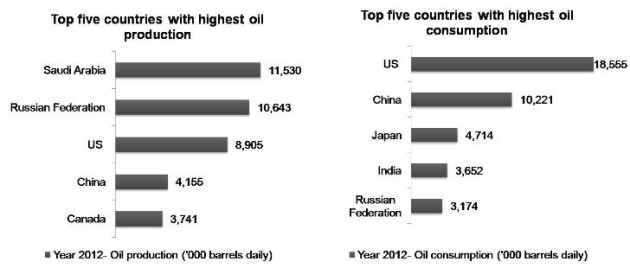Top 5 countries in the world with highest oil production and consumption
Petroleum is one of the most precious natural resources discovered by mankind. It has fuelled industrial growth in the past and is still being used as a primary source of energy across multiple industrial sectors. This magic fuel is a complex mixture of hydrocarbons. Due to its form and high calorific value content, it has become very popular. Its vital role in energizing industrial growth has changed the world economy. However, use of petroleum started only recently. Before the initiation of Industrial revolution in 19th century, energy consumption relied on muscular and biomass sources.
Industrial revolution brought about a major shift in energy uses from traditional sources to more efficient fossil fuels such as coal. It basically triggered because of the technological inventions such as steam engines. Later on, with the help of evolving technology, mankind began using higher energy content sources like oil. Oil is in liquid form and occurs naturally in rock formations. It has very high calorific value and can be conveniently used with the help of internal combustion engines. Presently, mankind has become increasingly dependent on oil for its energy needs.
According to the International Energy Agency (IEA), countries such as Russia, Saudi Arabia, United States, China, Iran, Canada, United Arab Emirates, Venezuela, Kuwait, and Iraq accounted for over 63% of the world’s oil production (year 2011). Following map shows oil reserves distributed across the world-

Oil has dominated the world energy market since mankind first started using it. In fact, the growth rate of a country can also be assumed on the basis of its oil consumption volume. Mostly, Europe and United States pioneered economical growth fuelled by oil. Developing countries are still struggling for the same considering growing demand of the oil and subsequent growth in its price per barrel.
Following graph shows top five countries with highest oil production and consumption across the world. Saudi Arabia, Russia, United States, China and Canada were the top five countries in oil production. In terms of consumption, United States beats the entire world in being at the top position in oil consumption followed by China, Japan, India and Russia. All figures are for the year 2012.

In recent years, the world has experienced increasing demand for oil specifically due to high consumption rates from China and other developing countries. China, India and Brazil have experienced a growing demand for oil due to high growth rate in transportation sector. This demand is expected to increase in the coming years. However, demand for oil in developed countries is expected to be steady for next decade due to energy efficiency measures taken by the government through various policy level interventions.
India is the fourth largest oil consumer in the world (year 2012). In India, the consumption rate for oil grew at 4% (CAGR) from year 2002 to 2012. The Indian economy is growing rapidly. Energy is the key requirement in economic development. The Ministry of Petroleum & Natural Gas has taken several measures for enhancing exploration for the petroleum products. However, rate of production for oil grew at only 1% (CAGR) from year 2002 to 2012. The backlog in availability of oil in India is being fulfilled from expensive imports.

Coal is still the dominant energy source in India followed by petroleum products and biomass. Large population in Indian villages is using biomass/fuel wood for daily energy needs. However, in the past three decades, large populations have shifted to urban areas and therefore, their energy requirement has also shifted from traditional biomass to petroleum products and electricity. Government of India is working hard to secure energy sources for the demand of growing population. Some of the plans of the government are – increasing hydrocarbon production, extraction of coal-bed methane and shale gas and reducing subsidies on fuels for transportation.
Government of India is also taking efforts to bring energy efficiency and increase the share of renewable energy in India’s total energy mix. Schemes like Perform Achieve and Trade (PAT) under National Mission on Enhanced Energy Efficiency, National Mission for Hybrid and Electric Vehicles, Renewable Purchase Obligations (RPO) and National Solar Mission are primary steps by the government to bring energy efficiency and better energy security.
Data source: BP Statistical Review of World Energy June 2013
Disclaimer: Oil consumption figures also includes non-petroleum products and substitute fuels.
Image credit: World Oil Reserve Map




